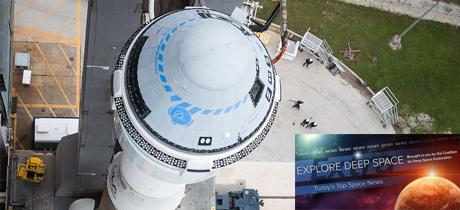In Today’s Deep Space Extra… Florida’s space coast awaits for a Friday 6:36 a.m., EST, liftoff of Boeing’s the CST-100 Starliner on a milestone uncrewed test flight to the International Space Station (ISS). New studies may help to explain how the solar system arranged the planets and life sustaining oxygen entered the Earth’s atmosphere.
Human Space Exploration
Starliner launch team driven by challenges, committed to safety
Coalition Members in the News – Boeing, United Launch Alliance
Florida Today (12/18): As Boeing’s CST-100 Starliner nears liftoff early Friday from Cape Canaveral Air Force Base, Florida, on a milestone uncrewed test flight to the International Space Station (ISS), United Launch Alliance’s Dane Drefke, Mechanical Operations Lead Engineer for launch pad preparations, and Melanie Weber, Boeing’s Launch Pad Lead, discuss some of the challenges for preparing the capsule for its flight atop a ULA Atlas V. As a NASA Commercial Crew Program partner, Boeing is striving to certify the spacecraft for the regularly scheduled transportation of astronauts to and from the Space Station next year. Launch is set for 6:36 a.m., EST.
Starliner set for its historic debut flight on Friday morning
Coalition Member in the News – Boeing
Ars Technica (12/18): Friday’s planned launch of Boeing’s CST-100 Starliner on a much anticipated uncrewed test flight to the International Space Station (ISS) and return to Earth on December 28, promises to foreshadow a breakthrough in 2020, the emergence of new U.S. commercial capabilities to transport astronauts to and from Earth orbit. SpaceX conducted a similar uncrewed test flight to the Space Station in March. Both companies are at work in achieving milestones established under NASA’s Commercial Crew Program to begin regularly scheduled missions with astronauts in 2020, something not possible in the U.S. since NASA’s shuttle fleet was retired in 2011.
Space Science
NASA’s Mars 2020 rover completes its first drive
NASA/Jet Propulsion Laboratory (12/18): NASA’s Mars 2020 Rover demonstrated its ability to move forward, backward and pirouette in a Jet Propulsion Laboratory (JPL) clean room on Tuesday. The drive test was a precursor to a July/August 2020 launch to Mars, where it is to land at Jezero Crater in February 2020 to seek signs of past microbial life and collect and cache samples of rock and soil for eventual return to Earth. “A rover needs to rove, and Mars 2020 did that yesterday,” John McNamee, the Mars 2020 project manager, said Wednesday.
China’s far side Moon rover breaks lunar longevity record
Space.com (12/18): Operating on the Moon’s far side, China’s Yutu 2 lunar rover, part of the Chang’e 4 mission, has broken the record for lunar surface activities held by the former Soviet Union’s Lunokhod 1 rover of 10 1/2 months in 1970-71 in the Sea of Rains. Chang’e 4 launched on December 7, 2018.
How the planets got their spots
The Economist (12/18): A seemingly orderly lineup of spots, or places, in the solar system in which each planet resides was hardly so. During the solar system’s early era, the planets moved closer to the sun, then away, looking for a stable lineup.
The asteroids might remember a forgotten giant planet
Space.com (12/18): Jupiter and Saturn perhaps other early large planets appear to have shaped the solar system, and a log of how that transpired may lie within the formation and evolution of the asteroids, explains Ohio State University researcher Paul M. Sutter.
Science fiction might be right after all. There might be breathable atmospheres across the universe
Universe Today (12/18): A steady rise in the discovery of planets around other stars has prompted studies of how many orbit within the habitable zones of their stars, where environmental conditions would support biological activity. That includes the presence of sufficient oxygen in the atmosphere. A new study led by a Leeds University researcher in the U.K. points to a rise in oxygen on Earth about three billion years ago due to microbial activity and plate tectonics, processes not confined to just Earth.
Other News
Spending bill highlights ongoing debate on Commerce Department’s role in space traffic management
SpaceNews.com (12/17): U.S. House and Senate 2020 fiscal year spending measures that emerged from the two houses appears unlikely to resolve the role of the Commerce Department, or its Office of Space Commerce, in handling civil space traffic management. In June 2018, the White House issued Space Policy Directive 3, directing Commerce to assume responsibility now held by the U.S. Air Force so the military could focus on its own national security space assets.
Original Firefly shareholders sue Firefly’s Markusic, Polyakov alleging fraud
Parabolic Arc (12/17): Original shareholders are suing Firefly Space Systems co-founder and CEO Tom Markusic, alleging he conspired with Ukrainian billionaire Maxym Polyakov to force a 2017 bankruptcy and reconstitution without compensation to Firefly’s original backers.

